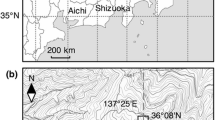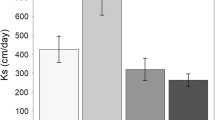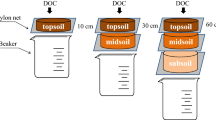Abstract
To identify the controls on dissolved organic carbon (DOC) production, we incubated soils from 18 sites, a mixture of 52 forest floor and peats and 41 upper mineral soil samples, at three temperatures (3, 10, and 22°C) for over a year and measured DOC concentration in the leachate and carbon dioxide (CO2) production from the samples. Concentrations of DOC in the leachate were in the range encountered in field soils (<2 to >50 mg l−1). There was a decline in DOC production during the incubation, with initial rates averaging 0.03–0.06 mg DOC g−1 soil C day−1, falling to averages of 0.01 mg g−1 soil C day−1; the rate of decline was not strongly related to temperature. Cumulative DOC production rates over the 395 days ranged from less than 0.01 to 0.12 mg g−1 soil C day−1 (0.5–47.6 mg g−1 soil C), with an average of 0.021 mg g−1 soil C day−1 (8.2 mg g−1 soil C). DOC production rate was weakly related to temperature, equivalent to Q10 values of 0.9 to 1.2 for mineral samples and 1.2 to 1.9 for organic samples. Rates of DOC production in the organic samples were correlated with cellulose (positively) and lignin (negatively) proportion in the organic matter, whereas in the mineral samples C and nitrogen (N) provided positive correlations. The partitioning of C released into CO2–C and DOC showed a quotient (CO2–C:DOC) that varied widely among the samples, from 1 to 146. The regression coefficient of CO2–C:DOC production (log10 transformed) ranged from 0.3 to 0.7, all significantly less than 1. At high rates of DOC production, a smaller proportion of CO2 is produced. The CO2–C:DOC quotient was dependent on incubation temperature: in the organic soil samples, the CO2–C:DOC quotient rose from an average of 6 at 3 to 16 at 22°C and in the mineral samples the rise was from 7 to 27. The CO2–C:DOC quotient was related to soil pH in the organic samples and C and N forms in the mineral samples.








Similar content being viewed by others
References
Aitkenhead JA, McDowell WH 2000. Soil C:N ratio as a predictor of annual riverine DOC flux at local and global scales. Global Biogeochem Cycles 14:127–38.
Andersson S, Nilsson SI, Saetre P 2000. Leaching of dissolved organic carbon (DOC) and dissolved organic nitrogen (DON) in mor humus as affected by temperature and pH. Soil Biol Biochem 32:1–10.
Bengtson P, Bengtsson G 2007. Rapid turnover of DOC in temperate forests accounts for increased CO2 production at elevated temperatures. Ecol Lett 10:783–90.
Carter MR, Ed. 1993. Soil sampling and methods of analysis. Boca Raton, FL: Canadian Society of Soil Science, Lewis Publishers..
Christ MJ, David MB 1996. Temperature and moisture effects on the production of dissolved organic carbon in a Spodosol. Soil Biol Biochem 28:1191–9.
Cleveland CC, Neff JC, Townsend AR, Hood E 2004. Composition, dynamics, and fate of leached dissolved organic matter in terrestrial ecosystems: results from a decomposition experiment. Ecosystems 7:275–85.
Cronan CS, Aiken GR 1985. Chemistry and transport of soluble humic substances in forested watersheds if the Adirondack Park, New York. Geochim Cosmochim Acta 49:1697–705.
Currie WS, Aber JD 1997. Modeling leaching as a decomposition process in humid montane forests. Ecology 78:1844–60.
Dai KH, David MB, Vance GF 1996. Characterization of solid and dissolved carbon in a spruce-fir Spodosol. Biogeochemistry 35:339–65.
Davidson EA, Janssens IA 2006. Temperature sensitivity of soil carbon decomposition and feedbacks to climate change. Nature 440:165–73.
Don A, Kalbitz K 2005. Amounts and degradability of dissolved organic carbon from foliar litter at different decomposition stages. Soil Biol Biochem 37:2171–9.
Gödde M, David MB, Christ MJ, Kaupenjohann M, Vance GF 1996. Carbon mobilization from the forest floor under red spruce in the northeastern USA. Soil Biol Biochem 28:1181–9.
Judd KE, Kling GW 2002. Production and export of dissolved C in arctic tundra mesocosms: the roles of vegetation and water flow. Biogeochemistry 60:213–34.
Kalbitz K, Kaiser K, Bargholz J, Dardenne P 2006. Lignin controls the production of dissolved organic matter in decomposing foliar litter. Eur J Soil Sci 57:504–16.
Kalbitz K, Knappe S 1997. Influence of soil properties on the release of dissolved organic matter (DOM) from the topsoil. Z Pflanzenernaehr Bodenkd 160:475–83.
Kalbitz K, Solinger S, Park J-H, Michalzik B, Matzner E 2000. Controls on the dynamics of dissolved organic matter in soils: a review. Soil Sci 165:277–304.
Kemmitt SJ, Lanyon CV, Waite IS, Wen Q, Addiscott TM, Bird NRA, O’Donnell AG, Brookes PC 2008. Mineralization of native soil organic matter is not regulated by the size, activity or composition of the soil microbial biomass—a new perspective. Soil Biol Biochem 40:61–73.
McDowell WH, Likens GE 1988. Origin, composition, and flux of dissolved organic carbon in the Hubbard Brook valley. Ecol Monogr 58:177–95.
Michalzik B, Kalbitz K, Park J-H, Solinger S, Matzner E 2001. Fluxes and concentrations of dissolved organic carbon and nitrogen – a synthesis for temperate forests. Biogeochemistry 52:173–205.
Michel K, Matzner E. 1999 The release of DOC and DON from forest floors in relation to solid phase properties, respiration and N-mineralization. J Plant Nutr Soil Sci 162:645–52.
Møller J, Miller M, Kjøller A 1999. Fungal-bacterial interaction on beech leaves: influence on decomposition and dissolved organic carbon quality. Soil Biol Biochem 31:367–74.
Moore TR, Dalva M 2001. Some controls on the release of dissolved organic carbon by plant tissues and soils. Soil Sci 166:38–47.
Nadelhoffer KJ, Giblin AE, Shaver GR, Laundre JA 1991. Effects of temperature and substrate quality on element mineralization in six Arctic soils. Ecology 72:242–53.
Neff JC, Asner GP 2001. Dissolved organic carbon in terrestrial ecosystems: synthesis and a model. Ecosystems 4:29–48.
Neff JC, Hooper DU 2002. Vegetation and climate controls on potential CO2, DOC and DON production in northern latitude soils. Glob Change Biol 8:872–84.
O’Connell M, Baldwin DS, Robertson AI, Rees G 2000. Release and bioavailability of dissolved organic matter from floodplain litter: influence of origin and oxygen levels. Freshw Biol 45:333–42.
Paré D, Boutin R, Larocque GR, Raulier F 2006. Effect of temperature on soil organic matter decomposition in three forest biomes of eastern Canada. Can J Soil Sci 86:247–56.
Park J-H, Kalbitz K, Matzner E 2002. Resource control on the production of dissolved organic carbon and nitrogen in a deciduous forest floor. Soil Biol Biochem 34:813–22.
Paul EA, Morris SJ, Bohm SB. 2001. The determination of soil C pool sizes and turnover rates: biophysical fractionation and tracer. In: Lal R et al. Eds. Assessment methods for soil carbon. Boca Raton, FL: Lewis Publishers. pp 193–205
Qualls RG 2004. Biodegradability of humic substances and other fractions of decomposing leaf litter. Soil Sci Soc Am J 68:1705–12.
Qualls RG, Haines BL 1992. Biodegradability of dissolved organic matter in forest throughfall, soil-solution, and streamwater. Soil Sci Soc Am J 56:578–86.
Ryan MG, Melillo JM, Ricca A 1990. A comparaison of methods for determining proximate carbon fractions of forest litter. Can J For Res 20:166–71.
Schimel JP, Weintraub NM 2003. The implications of exoenzyme activity on microbial carbon and nitrogen limitation: a theoretical model. Soil Biol Biochem 35:549–63.
Thurman EM 1985. Organic geochemistry of natural waters. Netherlands: Nijhoff/Junk Po. p 497.
Acknowledgments
The incubation study was made possible by a grant from FLUXNET Canada to David Paré. Financial support was also received from the Natural Sciences and Engineering Research Council of Canada and BIOCAP Canada. We thank Mike Dalva, Stéphanie Rose, and Alain Courcelles for laboratory assistance and the following site collaborators for soil sampling: Brian Amiro, Alan Barr, Al D. Cameron, Larry Flanagan, Michael Lavigne, and Tony Trofymow. We also thank the two anonymous reviewers for their useful comments.
Author information
Authors and Affiliations
Corresponding author
Rights and permissions
About this article
Cite this article
Moore, T.R., Paré, D. & Boutin, R. Production of Dissolved Organic Carbon in Canadian Forest Soils. Ecosystems 11, 740–751 (2008). https://doi.org/10.1007/s10021-008-9156-x
Received:
Revised:
Accepted:
Published:
Issue Date:
DOI: https://doi.org/10.1007/s10021-008-9156-x




